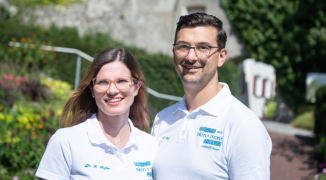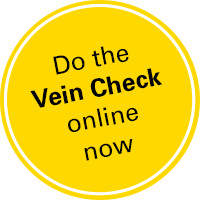A milestone in varicose vein treatment - Dres. Kofler on ELVeS Radial Laser Therapy
 Dr. Katrin Kofler and her husband Dr. Dr. Lukas Kofler have been jointly managing the skin + more MVZ in Biberach since 01.01.2023. In the care center the name is program. In addition to classical dermatology, the focus of treatment is on phlebology and dermatosurgery. The two dermatologists are renowned phlebologists (vein experts) who have been working together not only privately but also professionally since their further training as specialists. In the skin + more MVZ, the two now offer state-of-the-art diagnostic and treatment methods for varicose veins, including ELVeS radial laser therapy.
Dr. Katrin Kofler and her husband Dr. Dr. Lukas Kofler have been jointly managing the skin + more MVZ in Biberach since 01.01.2023. In the care center the name is program. In addition to classical dermatology, the focus of treatment is on phlebology and dermatosurgery. The two dermatologists are renowned phlebologists (vein experts) who have been working together not only privately but also professionally since their further training as specialists. In the skin + more MVZ, the two now offer state-of-the-art diagnostic and treatment methods for varicose veins, including ELVeS radial laser therapy.
Dr. Kofler and Mrs. Kofler, you both hold the additional qualification "Phlebology". Did you decide at the same time to obtain an additional qualification in venous medicine, and how did this come about?
LK: We were both in the Department of Venous Diseases at the University Dermatology Clinic in Tübingen during our time there. My wife became deputy head of the department and was in charge of both ultrasound and wound consultation. So it was a logical step for us to acquire the additional title of "phlebology".
KK: In fact, one focus of my work at the University Dermatology Clinic in Tübingen was the diagnosis and treatment of venous diseases. We acquired the qualifications for the additional designation at the same time, so to speak, and then also took the examination at the same time.
An example: I made an appointment because I think by a feeling of heaviness, pain or something similar that something is wrong with my legs. What exactly happens now?
LK: First, through history taking (conversation to gather the patient's medical history) and thorough physical examination, the complaint is narrowed down and a working diagnosis is made. If a vein disease is suspected, further instrumental diagnostics are performed, including ultrasound. This exact diagnosis enables us to offer a customized therapy for venous diseases.
Which venous disease patterns do you treat at skin + more?
KK: In addition to aesthetically disturbing spider veins, we primarily treat classic venous weakness, i.e. varicose veins. The focus here is on the modern endovenous laser, with which we can treat diseased veins gently and effectively.
LK: We also treat so-called 'side branch varicose veins', which are typically clearly visible on the surface of the skin as strongly tortuous veins: here, a few small punctures are sufficient, through which the diseased vein is removed in a minimally invasive manner.
You have discovered a varicose vein in a patient that requires treatment. What is the next step and what treatment options do you offer?
KK: After a physical examination and an ultrasound scan, as well as a so-called 'light reflex rheography' to measure vein function, the findings and the best individual treatment option are discussed with the patient. We then plan the intervention. If sclerotherapy (closing the vein by injecting a liquid or foamed sclerosant) is the treatment of choice, an appointment will be made in our outpatient clinic, followed by a follow-up appointment. If treatment with the ELVeS radial laser is planned, two appointments are also made here: first an outpatient appointment in our operating room and a follow-up appointment with renewed ultrasound examination a few days later. During the outpatient laser treatment, a laser fiber is inserted into the diseased vein under local anesthesia, which irradiates it from the inside with laser light. When the fiber is withdrawn, the vein is closed.
What advantages do you see in ELVeS radial laser therapy specifically and would you say that the therapy is suitable for everyone?
LK: ELVeS Radial Laser Therapy is a milestone in the therapy of pathologically altered veins. Compared to older lasers, the complication rates are significantly lower and the effectiveness of this procedure is excellent. With the wide selection of different laser fibers, this therapy is suitable for the vast majority of patients. One limitation would be a very tortuous course of the truncal vein.
KK: Great advantages of this treatment for me are also the short treatment time, the high comfort for patients and the excellent results - pain and bruising after the treatment are fortunately a rarity.
The laser treatment has been performed. What happens now?
KK: A great advantage is that laser therapy is performed on an outpatient basis, which means that patients go home after the procedure. Immediately after the laser treatment, a compression bandage is applied and a prophylactic (precautionary) blood thinner is injected - this reduces the risk of developing deep vein thrombosis. On the second day after the laser treatment, the patients come back to us; the success of the treatment is checked by ultrasound and then a compression stocking is put on.






